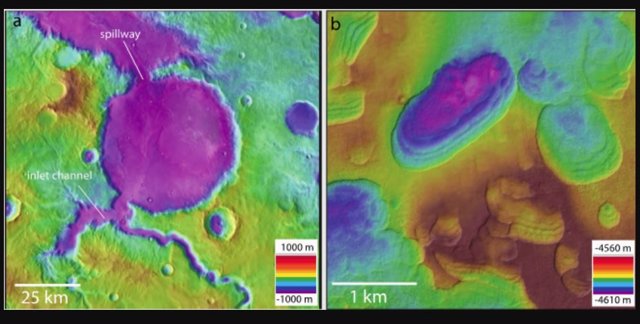An example of a large lake hosted by an impact crater on Mars (a) and a small lake hosted by permafrost on Mars – ESA/JPL/NASA/ASU/MSSS
Sep. 16 () –
Scientists may have drastically underestimated the number of ancient Martian lakes that once existed, a meta-analysis of years of satellite data from the Red Planet reveals.
Joseph Michalski, a geologist at the Department of Earth Sciences at the University of Hong Kong (HKU), and his international team recently published their results in Nature Astronomydescribing a global analysis of ancient Martian lakes.
“We know of approximately 500 ancient lakes deposited on Mars, but almost all of the lakes we know of are larger than 100 km2.” explains Michalski it’s a statement. “But on Earth, 70% of the lakes are smaller than this size and are found in cold environments where glaciers have retreated. These small-sized lakes are difficult to identify on Mars by satellite remote sensing, but they probably existed.” many small lakes. It is likely that at least 70% of Martian lakes have yet to be discovered.”
Scientists monitor these small lakes on Earth to understand climate change. The missing little lakes on Mars could also hold critical information about past climates.
The recent paper also reports that most of the known Martian lakes date to a period of 3.5 to 4 billion years ago, but each of the lakes could have lasted only a geologically short time (10,000 to 100,000 years) during this period of time. weather. This means that ancient Mars was probably also mostly cold and dry, but it warmed up episodically for short periods of time.
Michalski adds: “Because of the lower gravity on Mars and the pervasive fine-grained soil, the lakes on Mars would have been very cloudy and might not have allowed light to penetrate very deeply, which could present a challenge to photosynthetic life, if it did not exist.”
The lakes contain water, nutrients, and energy sources for possible microbial life, including light for photosynthesis. Therefore, the lakes are prime targets for astrobiological exploration by missions like NASA’s Perseverance rover now on Mars.
But Michalski cautions: “Not all lakes are created equal. In other words, some Martian lakes would be more interesting to microbial life than others because some of the lakes were large, deep, long-lived and they had a wide range of environments such as hydrothermal systems that could have been conducive to the formation of simple lifeFrom this point of view, it might make sense to target large, ancient and environmentally diverse lakes for future exploration.
“Earth hosts many environments that can serve as analogs to other planets. From the harsh terrain of Svalbard to the depths of Mono Lake, we can determine how to design tools to detect life elsewhere right here at home. Most of these tools are intended to detect the remains and residues of microbial life.said Dr. David Baker, an ecologist at HKU’s College of Biological Sciences who is knowledgeable about Earth’s microbial systems in lakes.










![[Img #74661]](https://thelatestnews.world/wp-content/uploads/2024/12/The-power-of-ultrasound-150x150.jpg)



![[Img #74661]](https://thelatestnews.world/wp-content/uploads/2024/12/The-power-of-ultrasound-300x200.jpg)

Add Comment